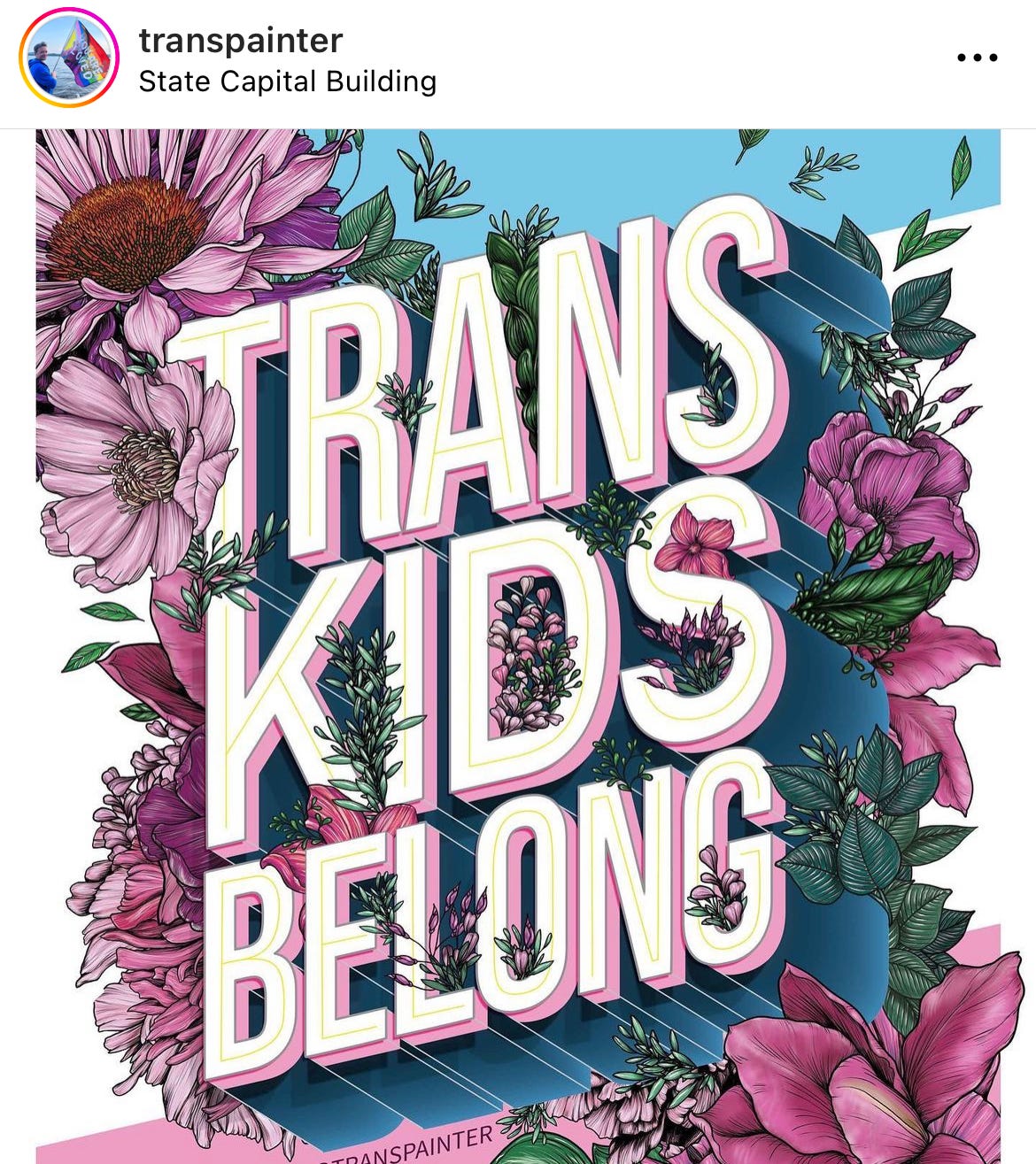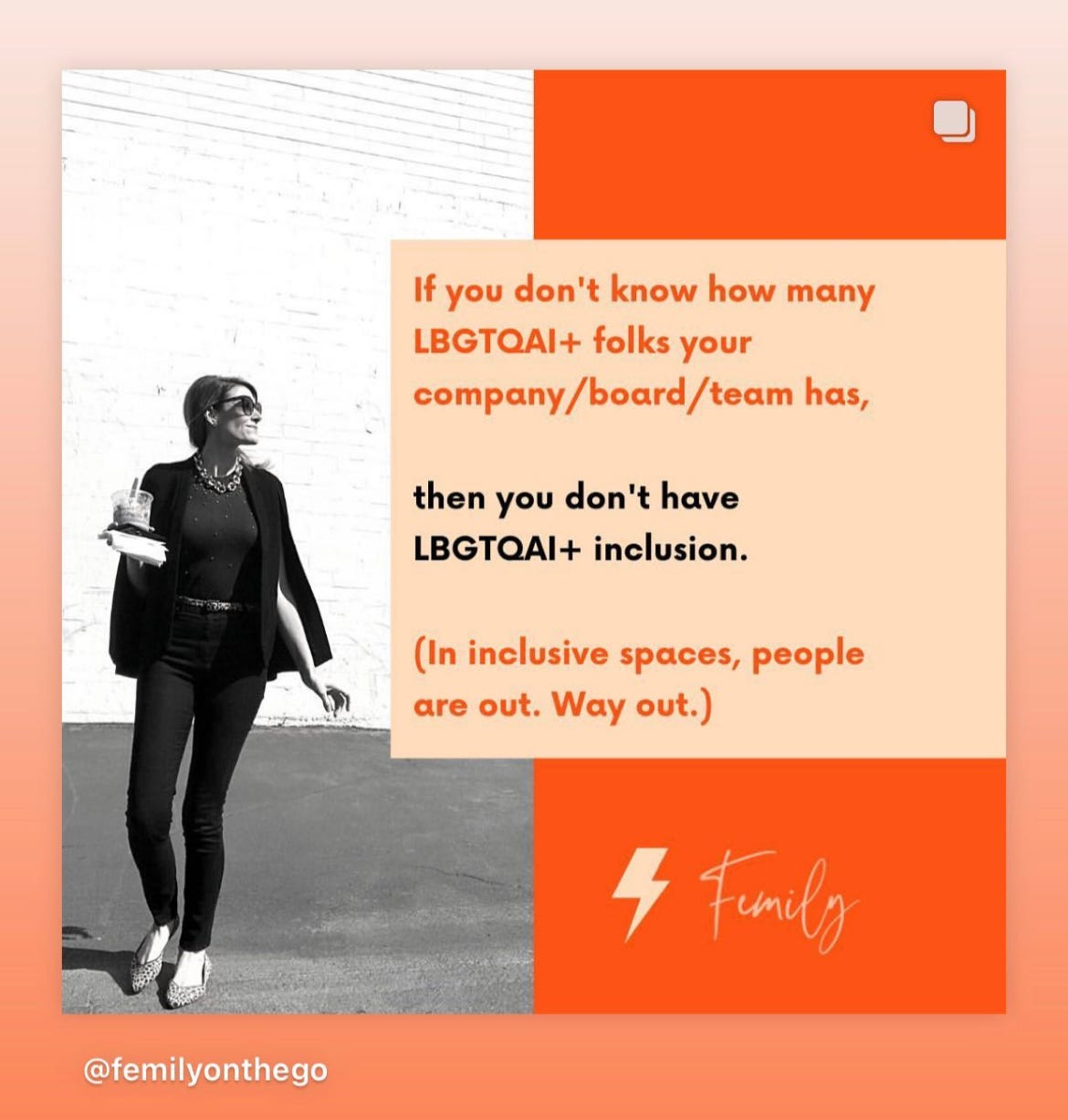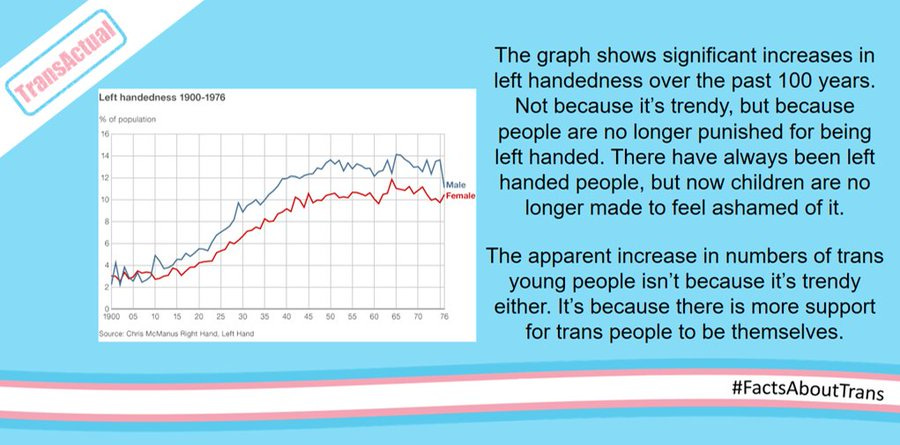Image use by permission of it’s creator, artist @Transpainter
A friend of mine is a Gender Inclusion consultant for tech companies in Silicon Valley. She just gave a seminar to HR representatives at a diversity conference, and in her speech (which she practiced on social media - a fabulous idea), she mentioned that more than 5% of young adults entering the work world identify as non-binary or transgender.
@Femilyonthego on Instagram
If you read my post last week you know that an issue has come up in our school district involving a group of parents who want to remove the confidentiality required by California State Education code from our Student Support plan document - the document school counselors fill out when a student wants to be called by another name, referred to by different pronouns, or use another locker room or restroom. This document does not provide physical transitioning advice, guidance, or counseling, just to be clear, it is purely for the purposes of supporting a student’s preferences at school. State and Federal privacy laws require the confidentiality, which it has maintained, unchanged, since about 2015. There are parents I know - supportive, loving, inclusive parents - who have questioned the need for taking a stand on this issue (no matter which side of the issue one stands on) since traditional statistics indicate it’s only about 1% of students who would be affected by a change in the confidentiality of this document. Ethical issues of discrimination and privacy aside, I dug deeper into the numbers.
I confirmed my friend’s statement with a 2022 PEW Research Center study that found 5.1% of Gen Z 18-25 year old young adults identified as non-binary or transgender. Why use Gen Z’s numbers to talk about schoolchildren? Because it’s quite likely a more accurate representation of the number of kids who already do or possibly will feel less comfortable identifying as the gender they were assigned at birth when they’ve moved out of their parents’ house.
Hence the confidentiality clause on the Student Support plan.
There could be any number of reasons for the statistic - which, if it holds true for children and teens, could mean as many as 500 kids in our district. The PEW study did not include statistics about hormone use, surgeries, or even requests for different names or pronouns, by the way. It simply asked respondents how they identified themselves.
Consider the emphasis we place on a child’s gender at birth. Baby showers with pink or blue themes, baby bedrooms decorated in gendered perfection, holiday and birthday gifts of trucks for boys and dolls for girls, and gendered language as some of the first words ever learned. Dividing the world into boys and girls is so baked into our culture that it becomes surprising to expect something different.
A parent I follow on Instagram explained that they and their partner were making an effort to give their child a choice in every clothing, toy, and book option they were presented with. They called it gender-creative parenting. One day, the child was offered a dress or overalls to wear, and chose the pants. The next day, it was a pink puffy jacket or a green one - the pink won. The next was a pink sweater or a blue one, and the pink was chosen. The same thing happened with toys and books, with no predictable patterns emerging in any of the child’s choices. It was almost as if - wait for it - the child chose what they were in the mood for that day without regard for convention or someone else’s ideas of what they should want to wear or read or play with.
Imagine if you had been able to figure out who you were/are with the full spectrum of identities and genders to freely choose from? How might you have identified? I think about that a lot. I wasn’t forced to do, wear, or like “girl things” as a child, so I don’t feel l was pushed into my femininity, but my spot on the spectrum of gender identity is not traditionally feminine, or for that matter, even strongly so, despite the fact that I enjoy being female. But I digress.
Is it more work for the Instagram parents to offer their child a choice every time? Probably. But the parents are giving their child agency in their own preferences, and I imagine that child will not grow up to tease a boy for wearing pink, or call a girl who plays with trucks a tomboy.
I spent my children’s young lives trying to avoid gender defaults. I made sure to talk about their future “partner” instead of “girlfriend” or “wife,” I continue to paint my youngest son’s nails for bagpipe competitions (painted nails stand out more when fingers are flying, and the band’s colors include a gorgeous shade of purple), and always opened my closet to them for high school class performances that involved dresses or cloaks. I did as much as I knew how to do, but it didn’t occur to me to go looking for more information about teaching inclusivity - I figured that would happen when we traveled (it did), and when they got to school. The evidence from my own kids seems to suggest that lessons in inclusivity did happen. The ethnic and racial diversity in their elementary school was far more pronounced than economic diversity, although gender inclusion wasn’t even part of the equation as far as I knew. Our dear friends are gay, so whatever combination of parents a child had was normal to our kids, but it wasn’t until my youngest was in high school, and his drum major in band was transgender, that I recognized the lack in my own education.
The amazing part is that the kids normalize everything. Transgender? Non-binary? Male? Female? Gay? Straight? Ace? Cool *shrug* whatever. And it wasn’t just band kids who could roll with whoever someone is, the same unfazed acceptance exists in drama, the arts, and in my kids’ school, robotics, STEM, and most of the sports too. So clearly, inclusive education is happening, but maybe its just kids’ innate acceptance and generosity that makes it so. According to a 2022 Time Magazine article, Gen Z is the only generation in the U.S. in which a majority - more than 50% - believes there are more than two genders.
There are parents, on the other hand, who struggle. A small, vocal faction of loud agitators seem to need control over everything from counseling confidentiality to the inclusive history taught in classrooms and required by law in California. We also struggle with our own defaults, and statistically, only about a third of Gen Xers accept that there are more than two genders. And this interesting stat, from the same Time Magazine article:
There’s another key difference among the generations when it comes to transgender or nonbinary identity. Most Boomer and Gen X people who identify as transgender were assigned male at birth. Among Gen Z, however, most transgender people were instead assigned female at birth.
It goes a long way toward understanding the fear that many older Americans harbor against transgender people - the toxic male fear of being “tricked” by a transgender woman, or the cis woman’s fear of being attacked in the bathroom by a “man.”
Now the more common experience is going from female to male, like actor Elliot Page (b. 1987), who came out as a trans man in 2020. “Despite feeling profoundly happy right now . . . I am also scared,” he wrote. “I’m scared of the invasiveness, the hate, the ‘jokes’ and of violence.”
But Gen Z has a different expectation of transgender or non-binary behavior - that is to say, they don’t have expectations, they have experience. With 52% of people under age 30 reporting knowing someone who is transgender or non-binary, they base their expectations on the people they know, which, as anyone who works with diversity and inclusion education, is a fundamental component to acceptance.
California Ed code states that all major stakeholders in our State must be included in social studies and history textbooks, and their significant histories must be taught. It means, for example, that an appropriate lesson about Civil Rights includes Martin Luther King Jr., Cesar Chavez, and Harvey Milk. And the struggle for voting rights for women is echoed in the drag queens’ efforts on behalf of LGBTQ+ rights at Stonewall. And since gender in nature is non-binary, it’s not a leap to teach inclusive human biology too.
Teaching kids about trans and non-binary genders doesn’t “turn them” into non-binary or transgender people, just like teaching me about men didn’t “turn me” male - it just doesn’t work that way. Societally, we have been bucking the “traditional” roles of men and women for decades. My mother graduated from law school when I was 13, so my experience of Mom was as a working professional in a male-dominated (at the time) profession, and my dad was a great cook (a traditionally feminine role), and some of our favorite meals were his. I wear jeans and a t-shirt, the uniform of most guys, six days out of seven, and my husband prefers a sarong on a hot day. What we do and how we look has crossed traditional gender lanes to the degree that nary an eyebrow is raised. It’s not so difficult to imagine that there could be gender lane crossing acceptance in identity and expression too.
The fact of the matter is that our children will very likely know someone (or maybe be someone) who doesn’t feel like they fit a traditionally male or female gender identity, and learning early that how a person identifies and who they love has no bearing on who they are as a friend, a brother, sister, sibling, neighbor, teacher, legislator, or hero will give them confidence and compassion as they navigate their relationships with other people. Character has no gender, and the character I want to demonstrate for my kids is supportive, kind, and accepting of other people with no designs on limiting, or even defining, who they are and how they express themselves.








Thank you for sharing this with us. I personally know several people who identify as non-binary, and a few are related to me. My own daughter, while she hasn't clearly stated so, would probably be one too. It's so important to make people feel happy in their own skin, and to make them feel accepted. Unfortunately, the parents of some of my young relatives don't always feel the same way.
Actually knowing someone who belongs to a certain group does help in accepting them, even if they are different from your own experiences.
My parents also had gay friends, so that was never anything unusual for me. Because of that, I always find it extremely surprising when I meet people my age who are not as accepting.
And if we as parents cannot get our children in touch with marginalised communities, we can talk about them. Share what we know so our children will not feel unsure when they meet someone who doesn’t share their background or experiences.
It’s exactly as you say: “Character has no gender, and the character I want to demonstrate for my kids is supportive, kind, and accepting of other people with no designs on limiting, or even defining, who they are and how they express themselves.”